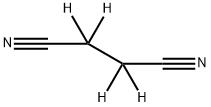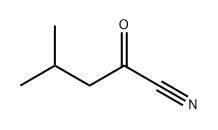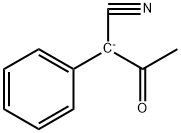BUTYRONITRILE
Synonym(s):Propyl cyanide
- CAS NO.:109-74-0
- Empirical Formula: C4H7N
- Molecular Weight: 69.11
- MDL number: MFCD00001968
- EINECS: 203-700-6
- SAFETY DATA SHEET (SDS)
- Update Date: 2024-12-18 13:37:16

What is BUTYRONITRILE?
Chemical properties
colourless liquid
Chemical properties
n-Butyronitrile has a sharp suffocating odor. Forms cyanide in the body. Butyronitrile [109-74-0], propyl cyanide, butanenitrile, CH3(CH2)2CN, is a colorless liquid slightly miscible with water, miscible with ethanol and diethyl ether. The physical properties are listed in Table 1. Butyronitrile is usually obtained by the catalytic gase-phase reaction of butanol or butyraldehyde with ammonia. Its major use is the manufacture of the poultry drug amprolium.
The Uses of BUTYRONITRILE
Butyronitrile is used as a chemical intermediate.
The Uses of BUTYRONITRILE
Basic material in industrial, chemical, and pharmaceutical intermediates and products; poul- try medicines.
The Uses of BUTYRONITRILE
Butyronitrile serves as an intermediate in the chemical and pharmaceutical industries. It is also involved in the preparation of n-butylamine, butanamide and butyric acid. It acts as a precursor to the poultry drug amprolium. Further, it reacts with phosphorochloridic acid diethyl ester to prepare (1-cyano-propyl)-phosphonic acid diethyl ester. It is also employed to study the effect of stereochemical factors on intervalence charge transfer. In addition to this, it is used in electrolyte composition in dye-sensitized solar cells.
Definition
ChEBI: A nitrile that is hydrogen cyanide in which the hydrogen has been replaced by a propyl group.
Production Methods
n-Butyronitrile is prepared from 1-butanol by controlled cyanation with NH3 at 300°C in the presence of Ni-Al203 or zinc phosphide catalysts.
General Description
A clear colorless liquid. Flash point 76°F. Less dense than water. Vapors heavier than air. Produces toxic oxides of nitrogen during combustion. Used in the manufacture of other chemicals.
Air & Water Reactions
Highly flammable. Slightly soluble in water.
Reactivity Profile
BUTYRONITRILE can react vigorously with oxidizing reagents, when heated to decomposition, BUTYRONITRILE emits highly toxic fumes of cyanides and oxides of nitrogen [Sax, 9th ed., 1996, p. 609]. Nitriles may polymerize in the presence of metals and some metal compounds. They are incompatible with acids; mixing nitriles with strong oxidizing acids can lead to extremely violent reactions. Nitriles are generally incompatible with other oxidizing agents such as peroxides and epoxides. The combination of bases and nitriles can produce hydrogen cyanide. Nitriles are hydrolyzed in both aqueous acid and base to give carboxylic acids (or salts of carboxylic acids). These reactions generate heat. Peroxides convert nitriles to amides. Nitriles can react vigorously with reducing agents. Acetonitrile and propionitrile are soluble in water, but nitriles higher than propionitrile have low aqueous solubility. They are also insoluble in aqueous acids.
Hazard
Flammable, dangerous fire risk.
Health Hazard
Dizziness, rapid respirations, headache, drowsiness, drop in blood pressure and pulse, delayed symptoms. May cause cyanosis (blue-grey coloring of skin and lips due to lack of oxygen)
Health Hazard
n-Butyronitrile is considered a highly hazardous material and full precautions should be used to prevent skin contact or inhalation of the vapor. Inhaled n-butyronitrile is about 2.4 times as toxic as acetonitrile. In order to protect workers, the recommended TWA limit is obtained by dividing that for acetonitrile by the factor 2.4. NIOSH has therefore recommended that employee exposure should not exceed 8 ppm (v/v) (22 mg/m3) compound as a TLV-TWA.
Health Hazard
Butyronitrile showed moderate to high toxicity on test animals. It is an acute toxicant by all routes: inhalation, ingestion, and absorption through skin. The target organs are the liver, kidney, central nervous system, lungs, and sense organs, as well as the peripheral nerve. Its toxicity is on the same order as that of propionitrile; its inhalation toxicity is slightly lower than that of propionitrile, and its oral toxicity is slightly greater than that of propionitrile.
Inhalation can cause nausea, respiratory distress, and damage to liver. Willhite (1981) reported a LC50 value of 249 ppm in mice from 1 hour exposure to its vapor. It produced ataxia, dyspnea, and corneal damage in test animals when given intraperitoneally. The toxic symptoms from subcutaneous applications are tremor, dyspnea, respiratory depression, and spastic paralysis. It is toxic only at low levels by skin absorption.
LD50 value, oral (mice): 27.7 mg/kg
There is no report on its teratogenicity. The reproductive effect of this compound is expected to be similar to that of propionitrile.
Fire Hazard
Special Hazards of Combustion Products: Toxic cyanide fumes
Flammability and Explosibility
Highly flammable
Industrial uses
n-Butyronitrile is used as an industrial solvent, an intermediate in the chemical industry and in poultry medicines.
Safety Profile
A poison by ingestion, skin contact, intraperitoneal, and subcutaneous routes. Moderately toxic by inhalation. Experimental reproductive data. A skin irritant. Dangerous fire hazard when exposed to heat, flame, or oxidizers. To fight fire, use alcohol foam. When heated to decomposition it emits toxic fumes of NOx and CN-.
Purification Methods
Treat it with conc HCl until the smell of the isonitrile had gone, then dry with K2CO3 and fractionally distil [Turner J Chem Soc 1681 1956]. Alternatively it is twice heated at 75o and stirred for several hours with a mixture of 7.7g Na2CO3 and 11.5g KMnO4 per L of butyronitrile. The mixture is cooled, then distilled. The middle fraction is dried over activated alumina. [Schoeller & Wiemann J Am Chem Soc 108 22 1986, Beilstein 2 IV 806.]
Waste Disposal
Burning in a chemical incinerator equipped with an afterburner and scrubber is the most effective way to destroy the compound. Oxidation with ethanolic–KOH can convert butyronitrile to nonhazardous cyanate.
Properties of BUTYRONITRILE
| Melting point: | −112 °C(lit.) |
| Boiling point: | 115-117 °C(lit.) |
| Density | 0.794 g/mL at 25 °C(lit.) |
| vapor density | 2.4 (vs air) |
| vapor pressure | 23 mm Hg ( 25 °C) |
| refractive index | n |
| Flash point: | 62 °F |
| storage temp. | Flammables area |
| solubility | slightly soluble in water; soluble in alcohol, ether and dimethylformamide |
| form | Liquid |
| color | Clear |
| Water Solubility | Miscible with benzene, alcohol, ether and dimethylformamide. Slightly soluble in water. |
| Merck | 14,1597 |
| BRN | 1361452 |
| Exposure limits | TLV-TWA 22.5 mg/m3 (8 ppm) (NIOSH). |
| Dielectric constant | 20.7(21℃) |
| Stability: | Stable. Combustible. Substances to be avoided include strong acids, strong bases, strong oxidizing agents and strong reducing agents. |
| CAS DataBase Reference | 109-74-0(CAS DataBase Reference) |
| EPA Substance Registry System | Butanenitrile (109-74-0) |
Safety information for BUTYRONITRILE
| Signal word | Danger |
| Pictogram(s) |
 Flame Flammables GHS02  Skull and Crossbones Acute Toxicity GHS06 |
| GHS Hazard Statements |
H225:Flammable liquids H330:Acute toxicity,inhalation |
| Precautionary Statement Codes |
P210:Keep away from heat/sparks/open flames/hot surfaces. — No smoking. P233:Keep container tightly closed. P240:Ground/bond container and receiving equipment. P280:Wear protective gloves/protective clothing/eye protection/face protection. P303+P361+P353:IF ON SKIN (or hair): Remove/Take off Immediately all contaminated clothing. Rinse SKIN with water/shower. |
Computed Descriptors for BUTYRONITRILE
BUTYRONITRILE manufacturer
New Products
Tert-butyl bis(2-chloroethyl)carbamate 4-Methylphenylacetic acid N-Boc-D-alaninol N-BOC-D/L-ALANINOL N-octanoyl benzotriazole 3-Morpholino-1-(4-nitrophenyl)-5,6-dihydropyridin- 2(1H)-one Furan-2,5-Dicarboxylic Acid DIETHYL AMINOMALONATE HYDROCHLORIDE 1,1’-CARBONYLDIIMIDAZOLE R-2-BENZYLOXY PROPIONIC ACID 1,1’-CARBONYLDI (1,2-4 TRIAZOLE) N-METHYL INDAZOLE-3-CARBOXYLIC ACID (2-Hydroxyphenyl)acetonitrile 4-Bromopyrazole 5-BROMO-2CYANO PYRIDINE 5,6-Dimethoxyindanone 5-broMo-2-chloro-N-cyclopentylpyriMidin-4-aMine 2-(Cyanocyclohexyl)acetic acid 4-methoxy-3,5-dinitropyridine 1-(4-(aminomethyl)benzyl)urea hydrochloride 2-aminopropyl benzoate hydrochloride diethyl 2-(2-((tertbutoxycarbonyl)amino) ethyl)malonate tert-butyl 4- (ureidomethyl)benzylcarbamate Ethyl-2-chloro((4-methoxyphenyl)hydrazono)acetateRelated products of tetrahydrofuran








You may like
-
 Butyronitrile CAS 109-74-0View Details
Butyronitrile CAS 109-74-0View Details
109-74-0 -
 Butyronitrile CAS 109-74-0View Details
Butyronitrile CAS 109-74-0View Details
109-74-0 -
 Butyronitrile 99% CAS 109-74-0View Details
Butyronitrile 99% CAS 109-74-0View Details
109-74-0 -
 Butyronitrile CAS 109-74-0View Details
Butyronitrile CAS 109-74-0View Details
109-74-0 -
 Butyronitrile CAS 109-74-0View Details
Butyronitrile CAS 109-74-0View Details
109-74-0 -
 Butyronitrile CAS 109-74-0View Details
Butyronitrile CAS 109-74-0View Details
109-74-0 -
 118753-70-1 98+View Details
118753-70-1 98+View Details
118753-70-1 -
 733039-20-8 5-broMo-2-chloro-N-cyclopentylpyriMidin-4-aMine 98+View Details
733039-20-8 5-broMo-2-chloro-N-cyclopentylpyriMidin-4-aMine 98+View Details
733039-20-8